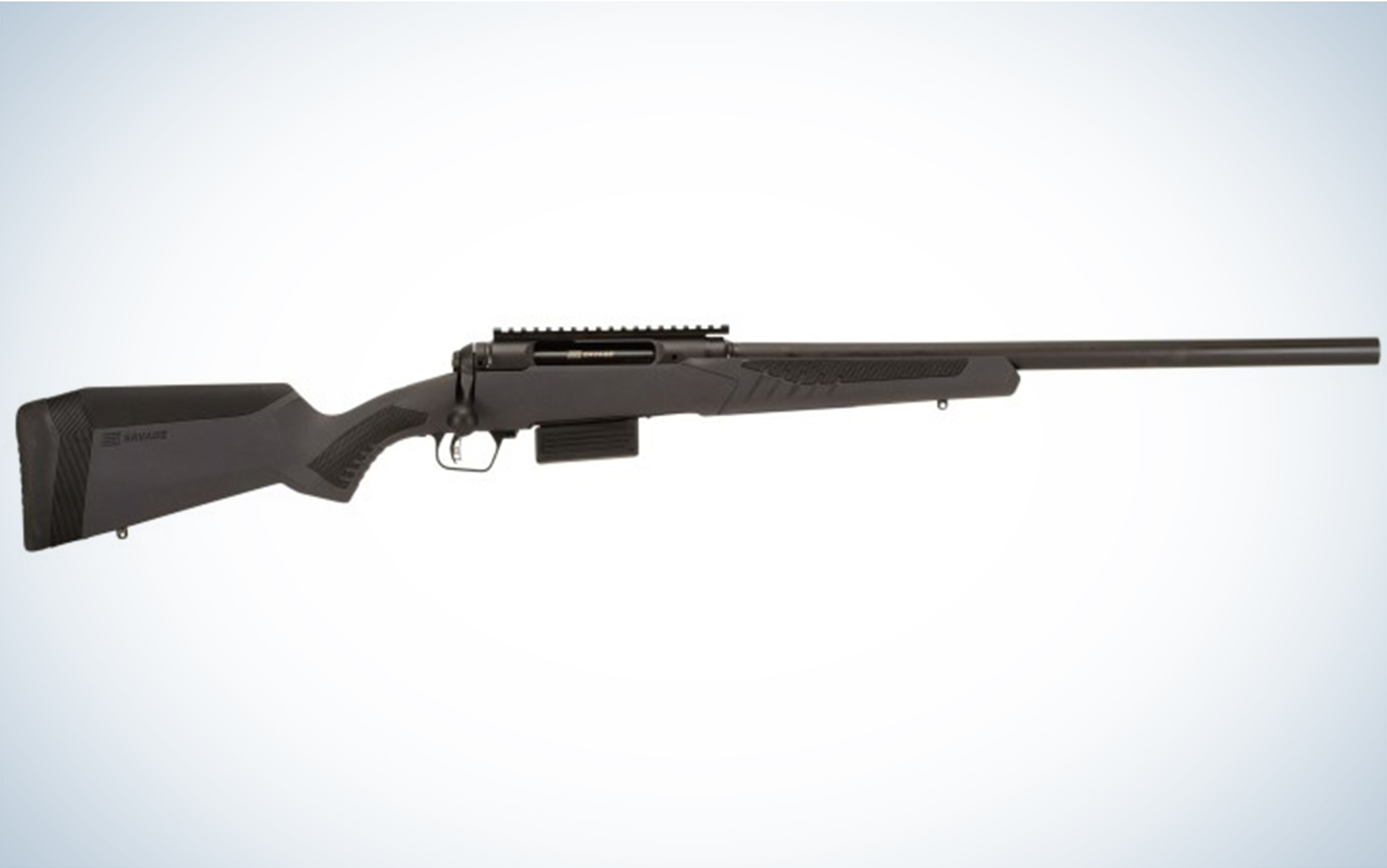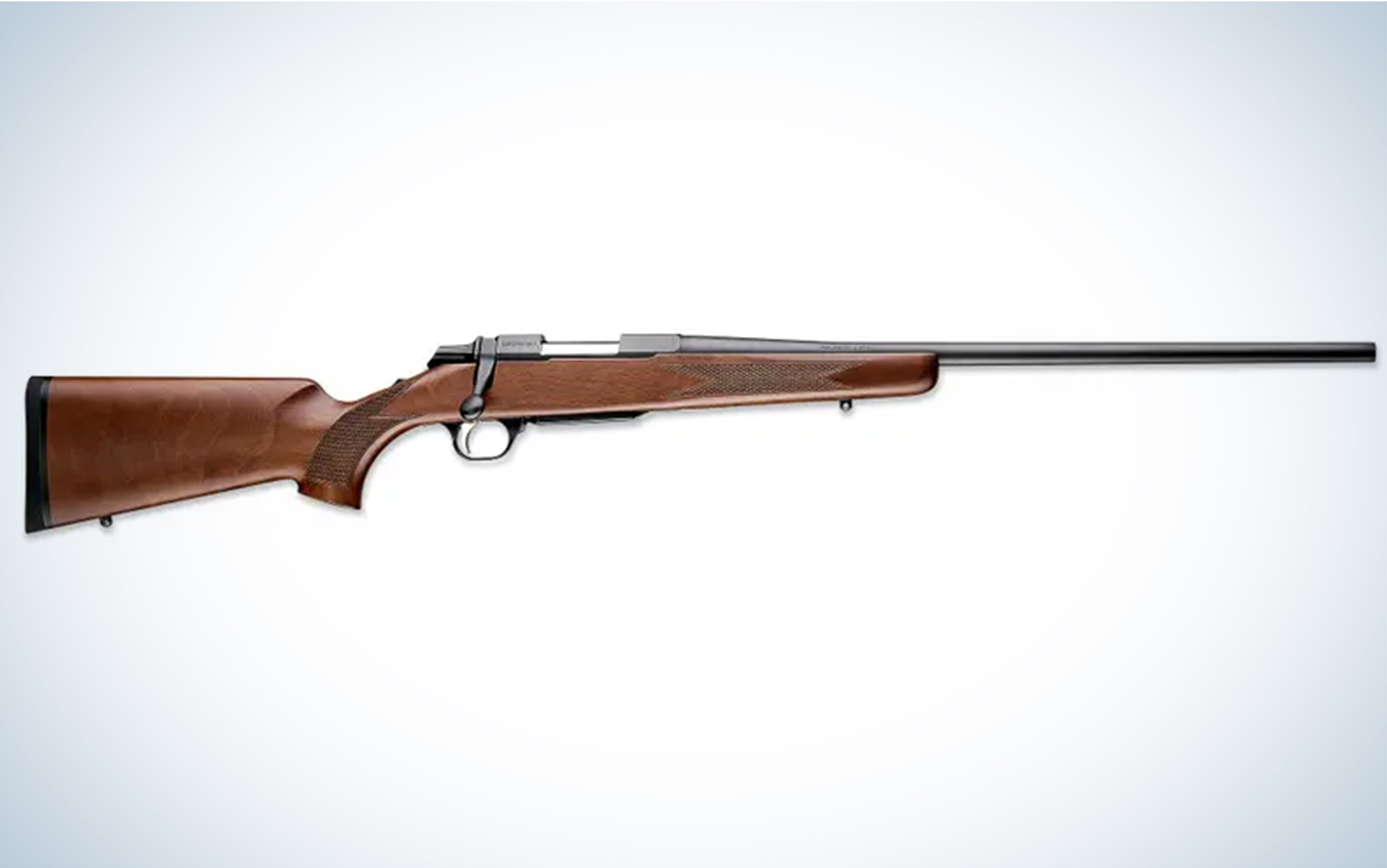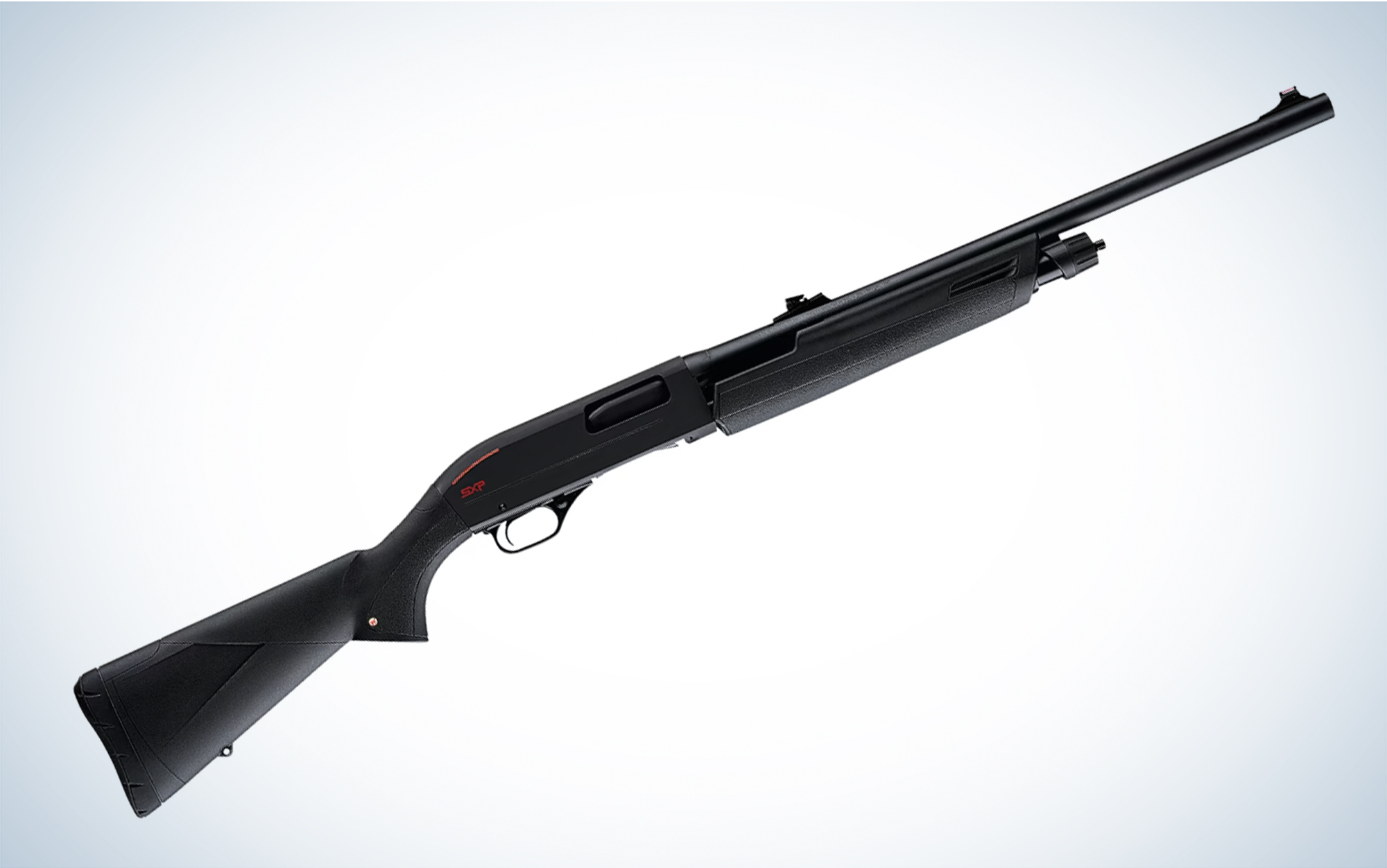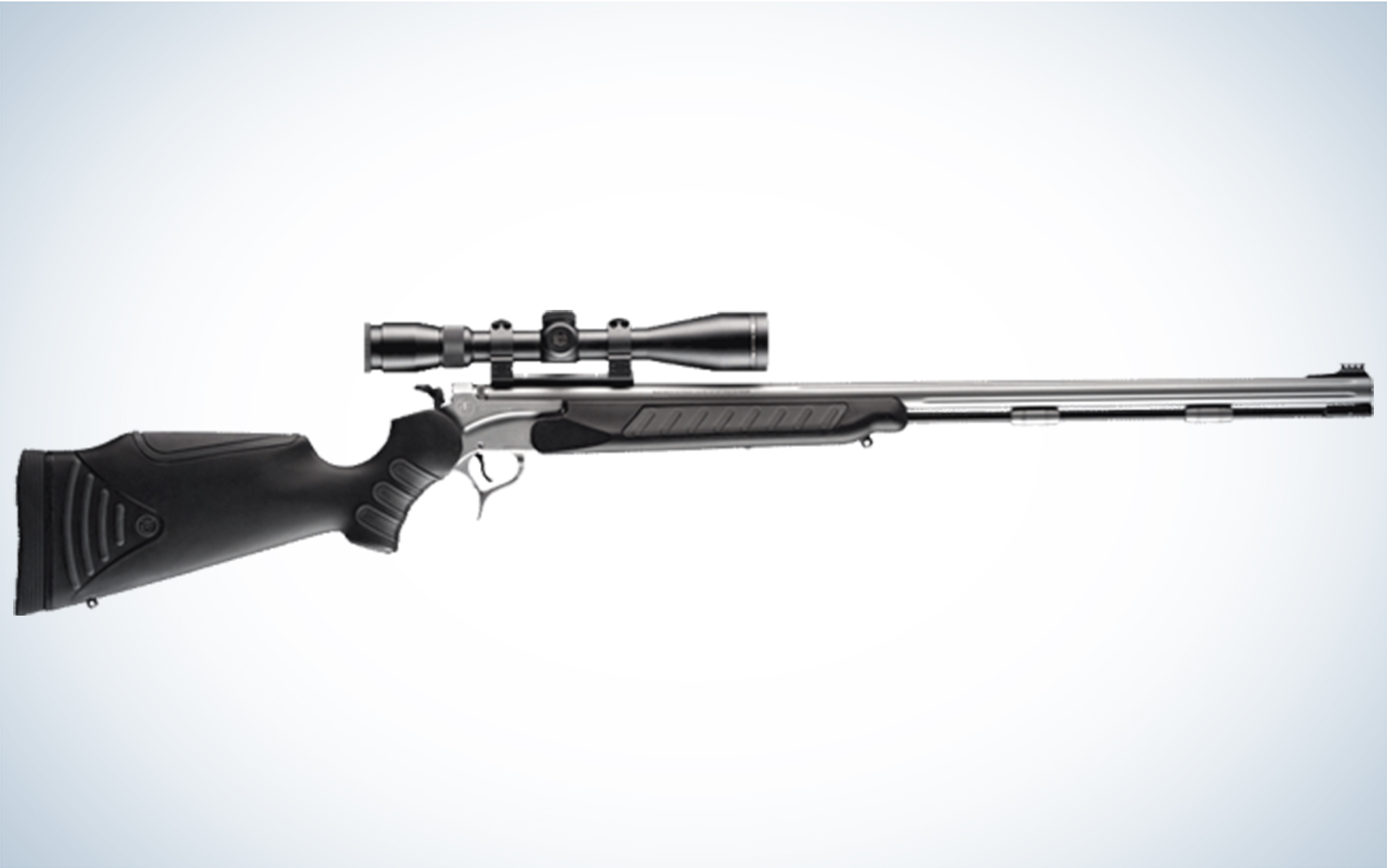We may earn revenue from the products available on this page and participate in affiliate programs. Learn More ›
Updated Jun 22, 2023 11:23 AM
The golden age of slug guns is likely over. As more states legalize straight-wall cartridges for deer hunting, more hunters are moving away from shotguns for deer hunting and toward rifles. However, the best slug guns will still punch clover leafs at 100 yards, and deliver deadly performance at that range.
Many major shotgun manufacturers are still marking dedicated slug guns with stocks, triggers, sights and barrels designed to squeeze the most out of modern ammo. Plus, many of the best shotguns for deer hunting that are no long in production can still be found on the used market.
Many of those classic slug guns still have a place among the ranks of the all-time greats. So without further ado, we’ve compiled a list of the best classic slug guns and the most advanced sluggers on the market. What follows is our ranking of the 15 best slug guns of all time.
RSG stands for Rifled Slug Gun, and you’d be hard-pressed to find one with more thought in its engineering. Randy Fritz, the TarHunt founder, made the RSG his pet project in the late 80s and early 90s, after the first rifled slug barrels hit the market. He wanted to create a rifle to shoot shotgun slugs that would far surpass anything else on the slug-gun market. Fritz accomplished this goal by combining benchrest bolt-action rifle technology with a rifled shotgun barrel. Today’s RSG has a glass-bedded action on a McMillan fiberglass stock. A heavy-walled Shaw barrel is threaded into the action and ported at the muzzle. The barrel twist and interior dimensions have also been carefully selected for optimum performance. There’s even a crisp 3 1/2-pound trigger. This is as “rifle like” a shotgun as you’ll ever find – and it’s an absolute tack driver.
Best Fit: The TarHunt is a long-range slayer for the accuracy snob. It is one of the all-time best shotguns for deer. At 7 3/4 to 8 1/4 pounds, it’s not the lightest nor the heaviest. It’s best for stand hunting over open terrain. Unfortunately, all that performance doesn’t come at a low price. Base price for the gun runs from $2,835 to $3,500, depending on if you choose 12, 16 or 20 gauge.
READ NEXT: Will Straight-Wall Deer Rifles Kill the Slug Gun?
The Winchester SX4 is known as one of the best affordable semi-auto shotguns on the market. The SX4 Cantilever Buck version of the line lives up to that reputation. As the name points out, this is a dedicated deer hunting gun with a rifled barrel, adjustable rifle-style sights with TRUGLO front fiber optic, and a Weaver-style cantilever optic mounting base, if you decide to mount a scope (which you should). Beyond those features, this shotgun is a typical SX4, which is to say that it has a reliable self-regulating gas system, comfortable ergonomics, and simple, intuitive controls. Both the 12-gauge and 20-gauge versions come with a 22-inch barrel. MSRP is $1,080.
Best Fit: This is the best deer hunting shotgun for someone looking for an affordable, reliable, and accurate semi-auto. This shotgun fits the “mid-priced” description, but for those few extra bucks you get more features and the promise of long-term reliability.
What “best of” shotgun list doesn’t include the Remington 870? The 870′s affordable price, modular design and readily-available parts make it the every man’s shotgun. That goes for slug shooters too. Probably one of the best deals in firearms history was the 870 Express Combo package, which includes a ventilated rib smooth barrel and a rifled slug barrel. Today, Remington offers nearly every slug gun configuration imaginable, from rifled barrels with open sights and standard stocks, to cantilever scope mounts and thumbhole stocks. It cames in 12- and 20-gauge with a standard 3-inch chamber or the Super Mag 3 1/2-inch model. Sadly, Remington, now called RemArms, no longer makes this version of the 870. The company’s new 870 Fieldmaster will replace Express, but there are plenty of used Express slug guns that can be found on the used market.
Best Fit: The 870 is the gun for anyone, but it’s a perfect fit for hunters on a budget (you can still get a combo for less than $600) and brush busters who either stalk their deer or drive woodlots with a group of hunters. And if you’re just getting into hunting with slugs, all you need to do is pick up a rifled barrel for that 870 that’s already in the back of your gun case.
READ NEXT: Best Pump Shotguns for Less Than $500
The Deerslayer earned its moniker throughout the years as being a reliable, bottom-ejecting pump shotgun dedicated to deer hunting – all that, despite being plagued by the uncertainty of constantly changing ownership of the Ithaca brand. Today, Ithaca resides in Upper Sandusky, Ohio, in the heart of a big-buck “slug state.” And it’s churning out an elaborate machine for its current Deerslayer version. The trigger is tuned to a 4- to 6-pound pull. The action is machined of one piece of steel. The 24-inch heavy-contour barrel is made without adding heat for soldering. And there’s a beautiful drop-tine deer engraved on the action. The standard Deerslayer II checks in at a reasonable 7 to 8 pounds. The Deerslayer III in 12 gauge weighs about 9 1/2 pounds. But thanks to the fluted, heavy barrel, Ithaca claims it is capable of 4-inch groups at 200 yards. That’s highly atypical of any pump-action slug gun.
Best Fit: If you’re a pump fan, especially if you’re an old-school Ithaca fan, the Deerslayer II offers you some slug gun nostalgia and modern American craftsmanship. It should suffice no matter how you hunt. The Deerslayer III, however, is the long-range slug hunter’s dream. Its advertised effective range compares to any slug gun on the market.
Savage did as Savage always does when it created the original Model 210. It created a reliable, accurate rifle at an affordable price. That early bolt-action slug gun has since evolved into the 12 gauge Model 212 and 20 gauge Model 220. Each is based on the proven Savage 110 action, with a 22-inch rifled barrel and a two-round detachable box magazine. The barrel is locked into the action with a unique locking nut found on all Savage bolt-action rifles. This nut ensures a perfect barrel-to-action fit. Best of all, it comes standard with the Savage AccuTrigger, which is worlds ahead of any trigger you’ll find on a pump or auto.
Best Fit: The 212 and 220 shotguns are perfect for the accuracy junky not wanting to drop the change needed for a custom or top-end rig. You should be able to find any of the configurations for less than $600, although my local gun shop sells the 220 in the mid-$400 range. Many hunters are buying into the capabilities of the 20 gauge slug for deer. If you buy a bolt action, you’ll surely appreciate the 20 gauge’s lesser recoil.
H&R Ultra Slug Hunter

Want simple? Here it is. H&R touts its Ultra Slug Hunter series as “No nonsense. Just pure deer-dropping performance.” This gun is as steel-and-wood as it gets. It has a simple break-action design with an exposed hammer, yet the Ultra Slug Hunter has a dedicated following among deer hunters for its superb accuracy – accuracy you won’t find for its low price anywhere else. Accuracy is a result of the heavy-duty barrel and comfortable stock dimensions. Most of the guns in the Ultra Slug Hunter lineup are fairly heavy, in the 8- to 9-pound range. That’s not a bad thing. Single-shot shotguns are notorious for their recoil, and this gun is no exception. If you do want something easier to carry, consider the Ultra Light Slug Hunter. It checks in at 5.25 pounds.
Best Fit: The exposed-hammer design is as simple as they come. Even cleaning it is a breeze. That makes it a good gun for a beginner that can withstand some recoil. However, it’s not a great carry gun, since cocking the hammer adds time to the shot and you likely have only one shot. It’s best for hunting in a stand or blind with a solid rest.
READ NEXT: Rifled vs. Sabot Slugs: Are You Shooting the Right Whitetail Load this Deer Season?
The Browning A-Bolt was first made available in a shotgun model in 1995, and it lasted only a few years. Those early guns, available with either a rifled barrel or smooth barrel configuration, became highly sought after by a niche group of Midwestern sluggers. Luckily, Browning recently reintroduced the A-Bolt Shotgun Hunter. It’s available with a walnut, camo synthetic or black synthetic stock in 12 gauge only. It has a 3-inch chamber and 22-inch barrel fitted with rifle sights. This is a workhorse gun and like any A-Bolt, it looks as good as it performs. But at about 7 pounds, you’ll definitely feel some recoil.
Best Fit: If you’re a Browning fan, this could fill your collection. For the rest of us, it’s a great option for a dedicated slug gun. It has all the same features and attention to detail as any A-Bolt centerfire rifle, with reliable bolt-action performance and accuracy.
The Winchester SXP Black Shadow Deer has a fully-rifled, 22-inch barrel and TRUGLO fiber optic iron sights. It comes drilled and tapped for optic mounts, so you can add a rifle scope or red dot sight. The SXP is known for its fast and smooth action that ejects and feeds quickly. It’s also easy to maintain. Field stripping just requires untwisting the magazine tube cap and pushing out the trigger assembly pin. The bolt carrier stays clipped to the rear of the action, until you depress the rear firing pin—so you won’t drop it accidentally. Once you pop it out you can clean the bolt, firing pin, and bolt-carrier group. Speaking of easy takedown, the plug is easily removed without tools. Another feature slug hunters will appreciate is the effective recoil pad, which removes some of the sting from 3-inch, 12-gauge slugs.
Best Fit: The Winchester SXP is only 6.12 pounds, which makes it great for carrying in the field all day, less so for managing recoil. It’s also a simple, reliable slug gun that holds five slugs and is easy to maintain. For deer hunters who spend all day still hunting through the woods and want an affordable pump shotgun, this is a great option.
The old 11-87 Premier was the gun I drooled over while thumbing through Remington catalogues as a kid. It could do everything the legendary 1100 could do, but with the capability of shooting 3-inch shells. It was also the gun of choice of many of my early deer hunting partners. Its gas action cushions the blow of hard-recoiling slugs, although some knocked the system for its pickiness with light loads and the need to occasionally replace the O-rings. The former is not a problem when shooting slugs. Although no longer offered in as many configurations as it was in its heyday, the 11-87 gas autoloader from Remington is still available in two versions with a rifled slug barrel and cantilever scope mount.
Best Fit: With a standard field stock, it’s a great fit for anyone looking for one gun to do it all. However, both rifled barrel models currently in production feature high combs – not a good choice for birds or clays but great if you want a dedicated slug gun at a middle price point.
The Slugster is the slug gun version of the popular Model 500 pump from Mossberg. Like all Mossberg firearms, it’s an affordable no-frills gun that you won’t feel bad about hunting with in rain, sleet and mud. Mossberg makes a variety of Slugster models and configurations in 12 and 20 gauge, with rifle sights or cantilever scope mounts, synthetic or wood stocks. If you’re a glutton for the heavy recoil of 3 1/2-inch shells, you could also reach for the Mossberg 835. The 835 is not a continuation of the 500; it was built from scratch for magnum loads. But it’s just as durable, reliable and affordable as the 500.
Best Fit: If you’re a budget hunter you won’t find a better deal than the Slugster. There’s not an MSRP in the Slugster lineup that tops $499. And if you’re a tactical junky, you can convert your favorite deer gun to a personal defense all star in the off season thanks to the myriad aftermarket components available.
Single-shot firearms don’t get any more glamorous than the Thompson Center Encore. Its interchangeable barrel system allows you to swap from centerfire to rimfire to muzzleloader to shotgun with relative ease. When you make the swap, the scope stays attached to the barrel, ensuring a certain level of maintained accuracy from one setup to another as the seasons change. Both the standard Encore and the jazzed-up Pro Hunter models are available with rifled slug barrels. A 20-gauge model is available in the standard Encore, which comes with a 24-inch barrel and rifle sights. The top-of-the-line 28-inch Pro Hunter slug barrel is in 12 gauge only.
Best Fit: If you already own an Encore and hunt in a “slug state,” adding a rifled slug barrel is a no-brainer. You’ll save money over buying another dedicated slug gun. Plus, the shape and dimensions of the Encore mimic many target-style rifles, which are highly comfortable to shoulder and shoot. It’s definitely a tree stand or ground blind gun.
The Rifled Slug model of the SBE 3 comes with open sights but is drilled and tapped for scope mounts. Its inertia-driven action that has made the SBE 3 so popular with waterfowl hunters is highly reliable, even if doesn’t cushion the felt recoil like a gas autoloader. Benelli also offers an optional high comb for more rifle-like performance. The MSRP of $1,999 is a little steep, but that’s the price to pay for premier performance. Hunters who like Benelli but are looking to save could consider the M2 Field Rifled Slug, which checks out at a few hundred less but utilizes the same inertia action. The M2 is also available in a 20-gauge version.
Best For: The Super Black Eagle is pigeon-holed as a waterfowler’s shotgun, but this gun is also a great option for those extreme slug gun hunters who drag their guns through just about anything and expect it to keep chuckin’ hulls.
The Model 1300 was first introduced in 1978 to succeed the Model 1200. Slug hunters first got their crack at owning a 1300 with a rifled barrel in the late 80s and early 90s, when several combo packages and deer-specific variations were introduced. Unfortunately, the 1300 disappeared in 2006 when U.S. Repeating Arms Co. shut down its Connecticut plant. It is still one of the fastest, slickest pump shotguns ever made. If you needed a fast follow-up shot but wanted pump-action reliability, the 1300 was your gun. I still see them pop up on the skeet range every now and then where they trail autos and doubles only slightly in the speed with which they’ll dust doubles.
Best Fit: If your style of hunting garners shots at moving deer, the 1300 is a good choice. You can still sniff out a deal on a used combo package if you’re lucky. Buy it and hold onto it.
Hey lefties, looking for a pump gun that won’t sling hulls into your face? The BPS might be your gun. Shells feed and eject from the bottom. Otherwise, it’s a workhorse pump gun that has been in Browning’s catalog since the 70s. It comes in 20 and 12 gauge with a 22-inch rifled barrel. The only slug gun option currently available is a classic walnut stock with blued barrel design that weighs about 7 1/2 pounds.
Best Fit: If you’re a fan of walnut and blued steel, your options are limited for slug guns. The BPS fits that bill with a proven design. It’s also a good choice for a left-handed shooter.
Read Next: Best Shotguns: 10 Greatest Shotguns Made in America
This bolt-action slug gun was a peer to the early Browning A-Bolts and Savage Model 210s in the mid- to late 90s, although it is now no longer available. Like many Marlin firearms, the Slugmaster was made for performance and durability, without all the pricey frills. A simple birch stock with pressed checkering and blued barrel are as pretty as it gets. But if you can find a clean used one with just a few season’s worth of hunting beauty marks on it, you’ll have yourself a fine slug gun.
Best Fit: Used Slugmasters can be had for a reasonable price when you find one. It would make a good, affordable first bolt-action slug gun, and a fine open-country slug gun for shooting from a blind or stand.
5 Ways to Make Your Slug Gun More Accurate
A modern saboted shotgun load is perfectly capable of delivering lethal performance at distances well beyond 100 yards. But can your deer hunting shotgun put that projectile where it needs to go? Dave Klotz of Da Mar Gunsmiths, a small shop located in Weedsport, N.Y., says you can with some modifications to your shotgun. Here’s what Klotz did to accurize a Remington 870 at a cost of $487.
Pin the Barrel
Shotguns are not rifles. Barrels are easily removed and tolerances aren’t tight where it slides into the receiver. “The barrel moves. It vibrates,” Klotz explains. “You don’t have to be a gunsmith to understand that a barrel that moves is not going to deliver consistent groups.” Klotz developed his pinning process about 35 years ago. He drills a hole through the side of the receiver and through the shank of the barrel, then inserts an Allen head screw to about five threads deep. The result is a barrel that doesn’t wiggle.
Improve the Bore
“Shotgun barrels usually don’t leave the factory in a condition that leads to really accurate shooting,” Klotz says. “We lap the bore, lengthen the forcing cone, and crown the barrel.”
The high polish in the bore after lapping helps minimize plastic buildup from sabots, which can degrade accuracy. Extending the forcing cone gives the slug a better transition into the rifling, Klotz says.
Fix the Trigger
It is nearly impossible to shoot well with the creepy 8-pound triggers typical of most production shotguns. “You can’t shoot accurately with a trigger like that,” Klotz says. Klotz’s shop used to be a Remington Service Center, and my 870 came back with a trigger that breaks crisply at 2 ¾ pounds.
Use a Better Scope Mount
Klotz doesn’t believe in barrels with cantiliver scope mounts. “On a shotgun, you need a mount that does not shoot loose and will not bend or break. There wasn’t one available, so we designed our own,” Klotz says.
The Da Mar mount uses six screws (three per side), and each screw is located on the sides of the receiver where the metal is thickest. It features a Weaver-style rail and rings.
Reduce Recoil
To take the sting out of my slug gun, Klotz did some bonus work and installed a Remington SuperCell recoil pad and put a steel plug in the stock to increase its weight. Slug guns are never a pleasure to shoot, but these alterations made a big difference and were no doubt part of the reason my groups improved.
Accuracy Results
While I wasn’t able to duplicate the 1.5-inch groups that the Da Mar guys got with Lightfield slugs, I was able to print the first 3-inch group I’ve ever shot with a shotgun, which is a far cry from what I had previously been able to do.
- Winchester Dual Bond: Before: 7.5 in. After: 3 in.
- Winchester Platinum Tip: Before: 8.25 in. After: 3.25 in.
- Winchester Partition Gold: Before: 9.5 in.After: 3.75 in.
- Remington Core-LoktBefore: 7.5 in. After: 4.25 in.
- Remington AccuTip: Before: 9.25 in. After: 5.5 in.
- Winchester XP3: Before: 8.75 in. After: 5.75 in.
––Tony Hansen
Outdoor Life is dedicated to covering safe and responsible gun ownership for hunting, recreation, and personal protection. We participate in affiliate advertising programs only with trusted online retailers in the firearms space. If you purchase a firearm using the links in this story, we may earn commission













